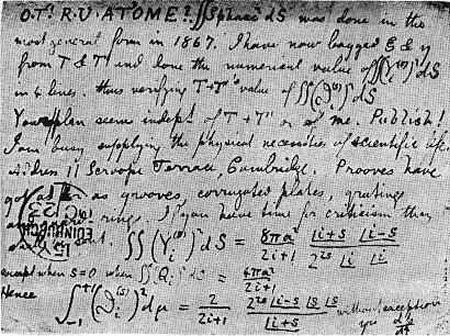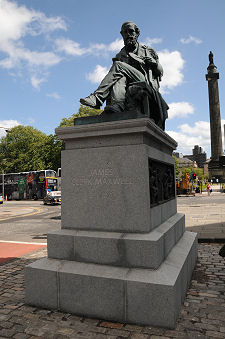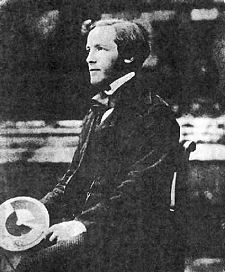 A Postcard from James Clerk Maxwell Note About Image Copyright |
James Clerk Maxwell lived from 13 June 1831 to 5 November 1879. He is widely regarded as one of greatest scientists of any era. His work on the theory of electromagnetism makes him the father of modern physics and he also made fundamental contributions to mathematics, astronomy and engineering. In 1931, on the centenary of Maxwell's birthday, Albert Einstein described Maxwell's work as the "most profound and the most fruitful that physics has experienced since the time of Newton."
James Clerk Maxwell was born at 14 India Street, in Edinburgh's, New Town the only child of Edinburgh lawyer John Clerk. He spent much of his early childhood on the family estate, Glenlair near Dumfries. His early education was provided by his deeply religious mother, but after her death when he was eight he went on to Edinburgh Academy. His nickname of "daftie" was earned by wearing home-made shoes on his first day at his new school.
In 1845 the 14 year old Maxwell wrote a paper describing a mechanical means of drawing mathematical curves with a piece of twine. Two years later he went to Edinburgh University, studying natural philosophy, moral philosophy, and mental philosophy. While still an 18 year old student in Edinburgh, Maxwell contributed two papers to the Transactions of the Royal Society of Edinburgh. The following year, 1850, saw Maxwell at Cambridge University. He graduated in 1854, the year in which he read to the Cambridge Philosophical Society a paper: On the Transformation of Surfaces by Bending. One of the few purely mathematical papers he published, it marked him out to his contemporaries as a man of genius. In 1854 he also published a paper entitled On Faraday's Lines of Force his first foray into the field of electromagnetics for which he was to become best known.
In 1856, Maxwell was appointed to the chair of Natural Philosophy (in effect, Professor of Physics) at Marischal College, Aberdeen. From there he moved in 1860 to King's College, London, and then, in 1871, to become the first Professor of Experimental Physics at Cambridge where he directed the newly created Cavendish Laboratory. It was at the Cavendish, over the next fifty years, that so much of the physics of today continued to develop from Maxwell's inspiration.
James Clerk Maxwell married Katherine Mary Dewar when he was 27 years old, but they had no children. He died at the age of 48 in 1879 in Cambridge of abdominal cancer.
Maxwell's genius stemmed from both the depth of the influence he had in a number of key areas, and from the breadth of the fields in which he made a significant contribution. His most important work was in the area of electromagnetism. He extended earlier work on electricity and magnetism by Michael Faraday, André-Marie Ampère, and others into a linked set of differential equations, now collectively known as Maxwell's equations. First presented to the Royal Society in 1864, they describe the behaviour of both electric and magnetic fields, and their interactions with matter.
He went on to show that his equations predicted waves of oscillating electric and magnetic fields that travelled through empty space at a speed that could be predicted from simple electrical experiments. In 1865 Maxwell wrote: This velocity is so nearly that of light, that it seems we have strong reason to conclude that light itself (including radiant heat, and other radiations if any) is an electromagnetic disturbance in the form of waves propagated through the electromagnetic field according to electromagnetic laws. It was this insight that has since caused many to consider Maxwell to be the key influence on physics between Newton and Einstein, and to rank alongside both in overall importance.
Not content with this, Maxwell did valuable work in the field of colour perception and colour blindness. One result was an experiment in 1861 in which he produced the world's first colour photograph, using three separate negatives and a set of red, green and blue filters. In 1859 Maxwell won the Adams prize in Cambridge for his paper, On the Stability of Saturn's Rings, in which he concluded the rings could not be completely solid or fluid. Maxwell demonstrated the stability of the rings could result from their consisting of numerous small solid particles.
And even if Maxwell had never developed an interest in electromagnetism, he would still have been regarded as an important scientist for his work on the kinetic theory of gases. In 1866, he produced a formula, called the Maxwell distribution, which gives the fraction of gas molecules moving at a specified velocity at any given temperature. In doing so he generalized the previous laws of thermodynamics. His work in this area is remembered primarily by a thought experiment still known as Maxwell's demon. He is commemorated in statue form in Edinburgh's George Street.


